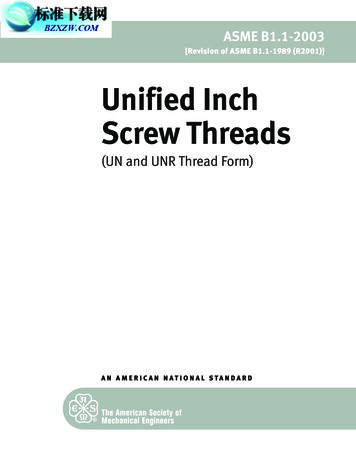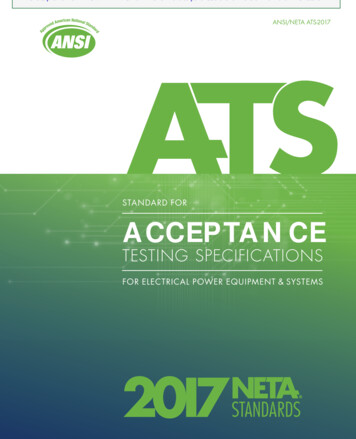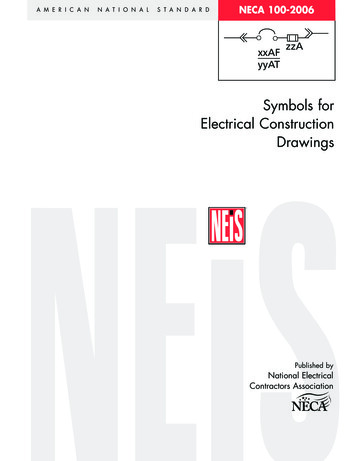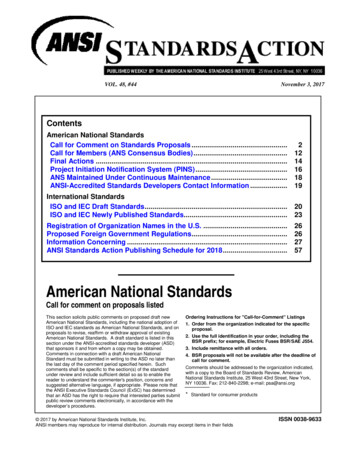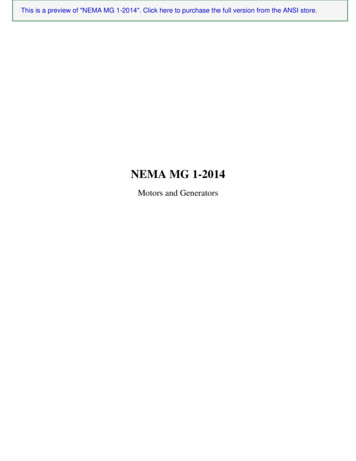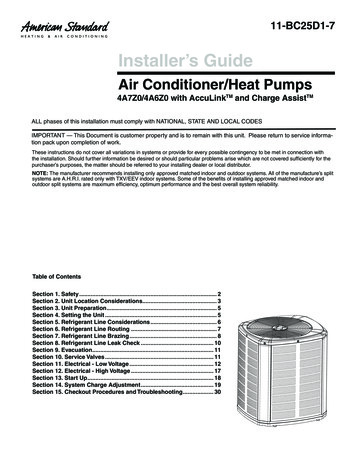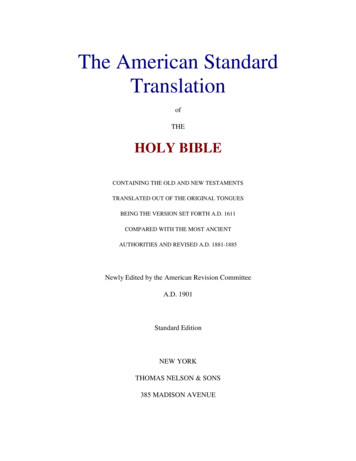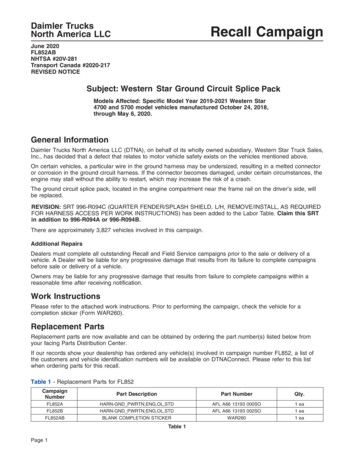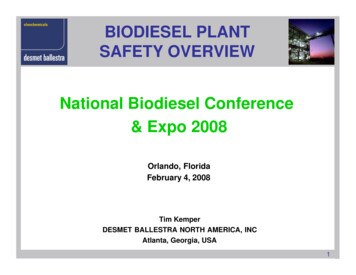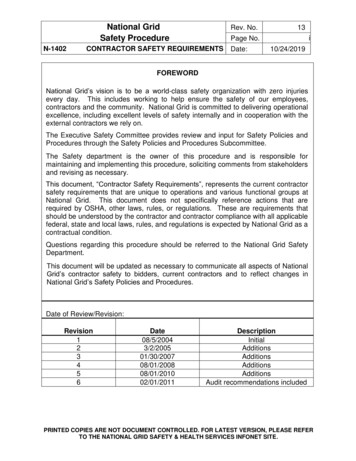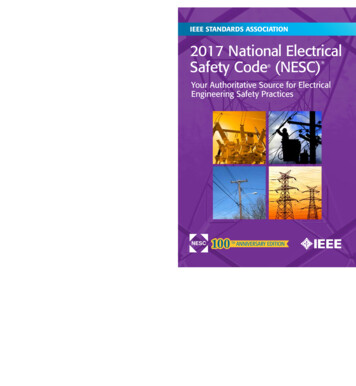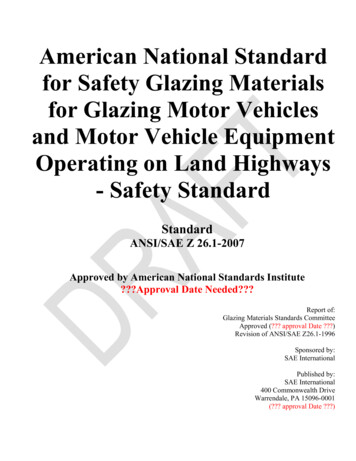
Transcription
American National Standardfor Safety Glazing Materialsfor Glazing Motor Vehiclesand Motor Vehicle EquipmentOperating on Land Highways- Safety StandardStandardANSI/SAE Z 26.1-2007Approved by American National Standards Institute?Approval Date Needed?Report of:Glazing Materials Standards CommitteeApproved (? approval Date ?)Revision of ANSI/SAE Z26.1-1996Sponsored by:SAE InternationalPublished by:SAE International400 Commonwealth DriveWarrendale, PA 15096-0001(? approval Date ?)
American National StandardApproval of an American National Standard requires verification by ANSI that the requirements for due process, consensus, andother criteria for approval have been met by the standards developer.Consensus is established when, in the judgment of the ANSI Board of Standards Review, substantial agreement has been reachedby directly and materially affected interests. Substantial agreement means much more than a simple majority, but not necessarilyunanimity. Consensus requires that all views and objections be considered and that a concerted effort be made toward theirresolution.The use of American National Standards is completely voluntary; their existence does not in any respect preclude anyone,whether he has approved the standards or not, from manufacturing, marketing, purchasing, or using products, processes, orprocedures not conforming to the standards.The American National Standards Institute does not develop standards and will in no circumstances give an interpretation of anyAmerican National Standard. Moreover, no person shall have the right or authority to issue an interpretation of an AmericanNational Standard in the name of the American National Standards Institute. Requests for interpretations should be addressed tothe Secretariat or sponsor whose name appears on the title page of this standard.CAUTION NOTICE: This American National Standard may be revised or withdrawn at any time. The procedures of theAmerican National Standards Institute require that action be taken to reaffirm, revise, or withdraw this standard no later than fiveyears from the date of approval. Purchasers of American National Standards may receive current information on all standards bycalling or writing the American National Standards Institute.ISBN 978-0-7680-1973-5Copyright 2007 SAE InternationalAll rights reserved.
Foreword(This foreword is not part of American National Safety Standard Z26.1-2007.)The American National Standard Safety Standard, Z26.1-1938, was developed by a sectional committee, national in scope,functioning under the procedure of the American National Standards Association and under the joint sponsorship of the NationalBureau of Casualty and Surety Underwriters (now the American Insurance Association) and the National Bureau of Standards. Itwas the first of several separate standards to be developed within the scope of Standards Committee Z26 on Specifications andMethods of Test for Safety Glazing Materials. That scope was as follows:Specifications and methods of test for safety glazing material (glazing material designed to promote safety andreduce or minimize the likelihood of personal injury from flying glazing material when the glazing material isbroken) as used for windshields, windows, and partitions of land and marine vehicles and aircraft.Since the original formulation of the American National Safety Standard, Z26.1-1938, the development of synthetic plasticmaterials has advanced so far that a number of them appear to be practical for certain uses as safety glazing materials for glazingmotor vehicles operating on land highways; therefore, in the 1966 edition of this standard the foreword and code were modified tothe extent necessary to include these synthetic plastic materials along with glass under the general term of "safety glazingmaterials" reserving the use of the word "glass" as applying only to the ceramic material, and of the word "plastic" as applyingonly to synthetic, organic, polymeric materials.Early in its deliberations, the Z26 Committee recognized the fact that no one set of specifications or methods of testing wouldapply to safety glazing materials as used for all purposes. Therefore, the members decided to prepare a separate standard for eachof the major usages included in the scope of the main project. In keeping with that decision, this standard, as its title indicates,pertains only to "Safety Glazing Materials for Glazing Motor Vehicles and Motor Vehicle Equipment Operating on LandHighways." Such motor vehicles and motor vehicle equipment shall include passenger cars, multipurpose passenger vehicles,trucks, buses, motorcycles, slide-in campers, pickup covers designed to carry persons while in motion, motorhomes, and trailers.It is hoped that the test procedures and performance requirements detailed in this standard may be uniformly adopted by motorvehicle commissioners and other interested regulatory officials as the basis for their approval of the safety glazing materials inmotor vehicles and motor vehicle equipment coming within their jurisdiction, or for incorporation in their regulations; that theymay serve as a guide to automobile manufacturers as to the safety glazing materials which will be acceptable to such officials; andthat they may enable the consumer (the commercial operator and the general public) to have assurance that the safety glazingmaterials in the motor vehicle that is purchased should reduce, in comparison with glazing of ordinary types, the likelihood ofinjury to persons riding in such motor vehicles and motor vehicle equipment by these safety glazing materials.It is the purpose of this standard to prescribe the functional properties of safety glazing materials in such a manner that they canbe used in any place in motor vehicles and motor vehicle equipment for which they possess those mechanical or opticalproperties, or both, that are requisite and appropriate. For example, safety glazing materials for windshields must pass a specifiedgroup of test requirements, all of which currently can be met only by certain laminated safety glazing; however, if and when othersafety glazing materials are developed which possess properties such that they, too, fulfill the requirements of the prescribed testsfor this location, they may also be used; and similar reasoning would apply for other locations. This standard is designed to servetwo purposes: (1) to afford a basis for standards for adoption in regulations by governmental regulatory bodies; or (2) for use bymotor vehicle commissioners or others as reference standards in such cases as they may have discretionary authority to adoptthese or other standards in connection with the approval of safety glazing materials or other items of use in or on motor vehicleequipment.This standard, which is the result of extended and careful consideration of available knowledge and experience on the subject, isintended to provide minimum requirements that are recommended for use, adoption, and enforcement by federal, state, and localadministrative authorities.Caution should be exercised not to make laws and regulations dealing with this subject so inflexible as to preclude subsequentadoption of technological advancements in the development of safety glazing materials.i
Except for special requirements for specified locations, safety glazing materials of seven general types can meet some or allrequirements detailed in this standard. Each of them possesses distinct performance characteristics. The seven types are listedbelow and defined in Section 1.(1) Laminated Glass(5) Multiple Glazed Unit (Class 1 and Class 2)(2) Glass-Plastic Glazing Material (6) Bullet-Resistant Glazing(3) Tempered Glass(7) Bullet-Resistant Shield(4) PlasticThe Z26 Committee and the Secretariat believe that this standard reflects the best current technology in the art of automotiveglazing. It is recognized that new developments are to be expected in safety glazing materials, and that revisions of the standardwill be necessary as the art progresses and as further experience is gained.Suggestions for improvement of this standard are welcome. They should be sent to the Secretariat at the Society of AutomotiveEngineers, Inc., 755 West Big Beaver Road, Suite 1600, Troy MI 48084 USA. This standard was processed and approved forsubmittal to ANSI by the Society of Automotive Engineers Glazing Materials Standards Committee. Committee approval of thestandard does not necessarily imply that all committee members voted for its approval.ii
CONTENTSPageSection 1.Section 1.25Bullet-Resistant Glazing . 1Bullet-Resistant Shield. 1Bus . 1Camper. 1Conductors . 1Glass-Plastic Glazing Material. 1Laminated Glass . 1Manufacturer. 1Model Number. 1Most Difficult Part or Pattern . 1Motorhome . 1Motor Vehicle . 1Multiple Glazed Unit . 1Multipurpose Passenger Vehicle (MPV) . 2Passenger car. 2Pickup cover . 2Plastic. 2Readily Removable Windows. 2Safety Glass . 2Safety Glazing Materials. 2Safety Glazing Plastics . 2Slide-in Camper . 2Tempered Glass . 2Trailer . .2Truck. 2General2.12.22.32.4Use of Descriptive Terms . 2Degree of Safety . 3Purpose of Tests. 3Referenced Standards. 3Section 3.Specimens To Be Tested3.1General . 33.1.1 Variation in Required Specimens . 33.1.2 Requirements for all Specimens . 33.2Multiple Glazed Units. 33.3Condition of Specimens. 3Section 4.Application of Tests4.1Definition of Item Numbers. 44.2Vehicle Type and Location. 7Section 5.Test Specifications5.1Light Stability, Test 1 . 75.2Luminous Transmittance, Test 2. 85.3Humidity, Test 3 . 85.4High Temperature, Test 4 . 85.5Impact, Test 5 (Ball Drop, 3.05 m [10 ft]) . 125.6Fracture, Test 6 . 125.7Impact, Test 7 (Ball Drop, Plastics, Table 2). 12iii
CONTENTS .185.195.205.215.225.235.245.255.26Impact, Test 8 (Ball Drop, Variable) (Multiple Glazed Unit, Class 2 Only) . 13Impact, Test 9 (Variable Temperature Ball Drop) . 13Optical Deviation and Visibility Distortion, Test 10 . 14Simulated Weathering, Test 11. 15Abrasion Resistance, Test 12 (Interior) . 16Abrasion Resistance, Test 13 (Exterior) . 19Chemical Resistance, Test 14 (Non-stressed). 19Chemical Resistance, Test 15 (Stressed) . 20Dimensional Stability, Test 16 (Warpage). 20Flexibility, Test 17. 20Flammability, Test 18 (1.27 mm [0.050 in] or Less in Thickness) . 21Flammability, Test 19 (More Than 1.27 mm [0.050 in] in Thickness). 21Penetration Resistance, Test 20 . 22Ballistics, Test 21. 22Resistance to Temperature Change, Test 22 . 22Impact, Test 23 (Ball Drop, 6.10 m [20 ft]) . 22Light Stability, Test 24 . 23Luminous Transmittance, Test 25. 23Optical Deviation and Visibility Distortion, Test 26 . 23Section 6.Edges . 23Section 7.Marking of Safety Glazing Materials . 23TablesTable 1Table 2Table 3Grouping of Tests . 9Height of Drop for Ball Impact Tests of Plastic Specimens . 13Vertical Burning Rates. 21Figure 1Figure 2Figure 3Steel Holding Fixture for Drop Test . 12Optical Deviation Method. 14Diagrammatic Arrangement of Taber Abraser Test Set-up . 18FiguresAppendixTable A1Glazing Material Applicability in Motor Vehicles. 25iv
1.Definitionssurface of the glazing faces inward when the glazing is mountedin a vehicle.1.1Bullet-Resistant Glazing1.7“Laminated glass" means two or more pieces of float glassbonded together by an intervening layer or layers of plasticmaterial. It will crack or break under sufficient impact, but thepieces of glass tend to adhere to the plastic. If a tear or opening isproduced, the edges are likely to be less exposed than would bethe case with ordinary annealed glass.“Bullet-resistant glazing" means a glazing material comprised ofone or more layers of glass bonded together with one or morelayers of transparent plastic or plastic material, solid or laminated,that can meet the requirements for bullet resistance of thisstandard (Test 21, Ballistics).Bullet-resistant glazing for motor vehicles operating on landhighways is available in various levels of resistance as specifiedin ANSI/UL 752-2005, Standard for Bullet-Resisting Equipment,Levels 1 through 8 and supplementary shotgun.1.81.9Bullet-Resistant Shield1.10 Most Difficult Part or Pattern“Most difficult part or pattern” means the worst-case product (e.g.size, thickness, geometry) within a glazing model number withrespect to fracture (Test 6) performance. The most difficult partor pattern is the part from each model number that typically hasthe largest fragments when broken in accordance with Test 6.When there is no difference in fragment size among several parts,the largest part shall be tested. Specimens shall be fracture tested(Test 6) without any hardware, soldered connectors, moldings, orencapsulation
American National Standards Institute require that action be taken to reaffirm, revise, or withdraw this standard no later than five years from the date of approval. Purchasers of American National Standards may receive current information on all standards by calling or writing the American
